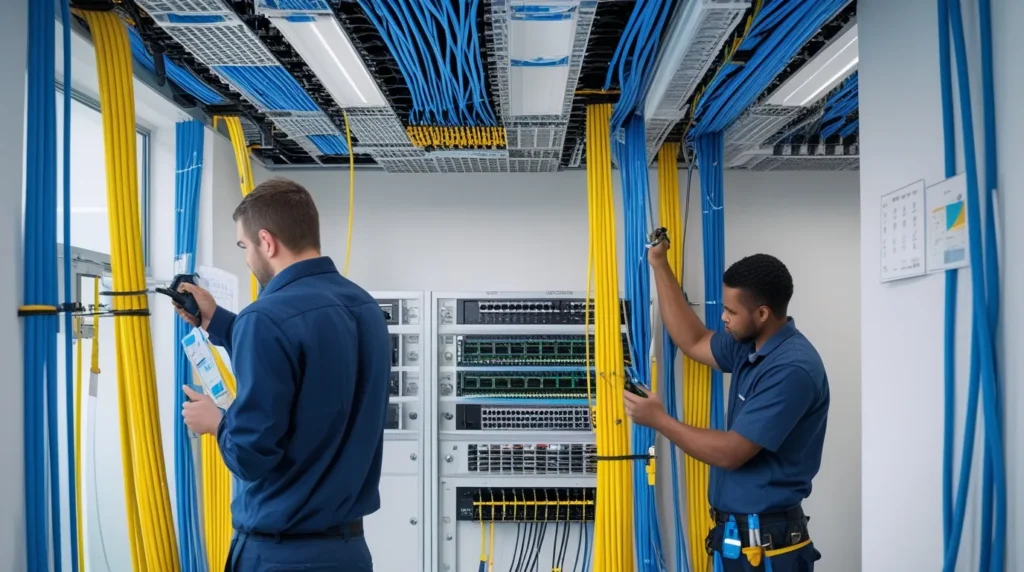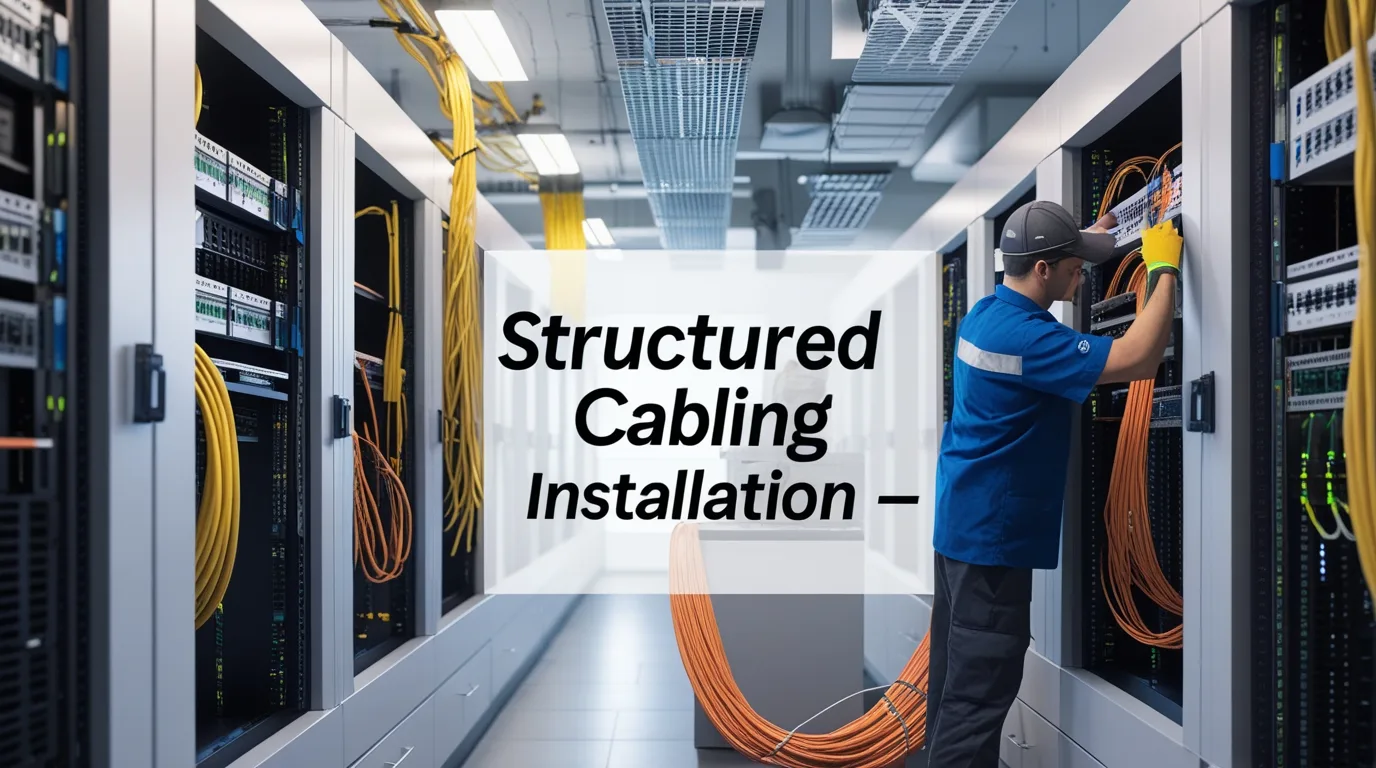What Is Structured Cabling and Why It Matters Today
Structured cabling is a system of wires and hardware that connects phones, computers, security cameras, and more. It keeps everything neat, safe, and easy to manage. When you use structured cabling installation, your network works better and faster. At Heritage Cabling, we know how important this is for schools, offices, and even homes. Instead of having random wires all over, a structured system brings everything together. This setup helps people work smarter and helps businesses save money over time. It also makes fixing things easier if something breaks. Structured cabling is smart planning for any space.
The Evolution of Communications Cabling in Modern Networks

In the past, people used separate wires for every phone and computer. It was messy and hard to fix. Over time, communications cabling changed to become more organized. Now, businesses use structured cable installation to bring all their devices together in one clean system. It helps everything stay connected, from video calls to printers. This change made networks stronger, faster, and easier to expand. With today’s technology, having strong cabling infrastructure is more important than ever. As new tools like smart boards and cloud systems grow, the need for structured wiring installation keeps growing too.
A Simple Guide to Structured Wiring Installation Basics
Structured wiring installation is the way wires are placed in a building so that they are neat and follow a plan. First, cable techs look at the space and decide where wires should go. They then install cables for internet, phones, and more. The wires usually go behind walls or in ceilings to stay hidden and safe. This makes the area look clean and helps avoid tripping hazards. Structured wiring services also use special panels that make it easier to fix or upgrade the system later. This method is much better than random wires running all over the place.
Understanding the Components of Structured Cabling Systems
Structured cabling systems have many parts. These include cables, patch panels, wall outlets, racks, and jacks. Each piece plays a role in helping data move across the network. Cables connect devices, patch panels group them, and outlets let you plug things in easily. Structured cable systems make sure all these pieces work together without problems. One great thing about a structured cabling system is that it follows a set design. This helps businesses know what they have and where it’s located. That way, if something goes wrong, it’s quicker to fix. It also makes upgrades much easier and faster.
How Structured Network Cabling Supports IT Growth

As businesses grow, they add more computers, phones, and devices. Structured network cabling helps all of these tools connect smoothly. Without a good cabling setup, internet speed can slow down and systems may crash. That’s why it’s important to use structured cabling solutions that can grow with your business. It structured cabling means planning for now and for the future. Structured wire systems also help with smart devices and cloud storage. When done right, a structured cabling solution lets a company add more equipment without redoing the entire system. It saves time, money, and keeps everything running smoothly.
Common Standards That Guide Structured Cabling Projects
To make sure everything works well, structured cabling standards must be followed. These are rules that cable techs use to design and install networks:
- Distance Limits: Standards define how far cables can run without losing signal quality.
- Cable Labeling: Each wire must be clearly marked to avoid confusion during repairs.
- Proper Routing: Cables should be placed to avoid interference from electrical systems.
- Test Procedures: All connections are tested to ensure strong, stable performance.
- Compliance Checks: Installations must meet local and industry-wide safety regulations.
- Upgrade Readiness: Good standards help future upgrades happen faster and easier.
Structured data cabling should always follow these rules so there are fewer problems later. A structured cable solution based on standards also helps when upgrading or fixing the network. Businesses trust companies like Heritage Cabling because we always follow these best practices. By using these guidelines, networks stay strong, safe, and ready for whatever the future brings.
From Planning to Performance: A Cabling Guide for Businesses

A good cabling guide starts with a strong plan. First, you think about what your space needs—like how many computers or phones will be used. Next, cable techs design a layout that includes structured cabling systems, wall jacks, patch panels, and more. Then comes the installation. After that, tests are run to make sure everything works. This full process helps make sure your cabling infrastructure is built right. Structured cabling companies use this method to avoid mistakes. When done well, it’s easy to add more wires later. That’s why planning is just as important as the actual installation.
Structured Cabling Installation: Steps and Best Practices
- Initial Walkthrough: Professionals assess your space and gather requirements.
- Network Design: A clear plan is drawn, showing wire paths and hardware placement.
- Cable Running: Wires are installed through walls and ceilings neatly and securely.
- Central Panel Setup: All wires connect to a main hub that controls the system.
- Labeling: Each connection point is labeled for quick future identification.
- Final Testing: Every connection is checked to ensure proper operation.
Structure cable installation done this way avoids future issues. With the right team, like Heritage Cabling, the job gets done neatly and follows all safety rules.
Choosing the Right Structured Cabling Solution for Your Space
Not every building is the same. That’s why you need the right structured cabling solution for your setup. Small businesses might need fewer cables, while large offices may need a full structured cable system. Cable techs can help decide what type of structured cabling system will work best. They look at how many people use the internet, if there are phones or cameras, and how fast data needs to move. Whether you need a structured cable solution for one room or an entire office, using a plan built around your needs will save time and money.
Why Businesses in Dallas, TX Trust Heritage Cabling
In Dallas, TX, many companies rely on Heritage Cabling to build strong, smart cabling infrastructure. Our team has years of experience and always follows structured cabling standards. We know what it takes to design, install, and maintain systems that work now and later. From structured wiring installation to full structured cabling solutions, we focus on what each client needs. We also make sure our work is neat, safe, and easy to upgrade. That’s why businesses in Dallas choose us again and again. Heritage Cabling makes sure your network is ready for today’s needs and tomorrow’s changes.
How to Hire Structured Cabling Companies You Can Rely On
Finding the right structured cabling companies takes some care. First, look for ones with good reviews and strong experience. Make sure they follow all structured cabling standards. Ask if they provide full services, from planning to testing. Reliable companies also explain things in simple ways and don’t rush the job. They should offer clear prices and tell you what to expect. The best structured wiring services come from teams who know what they’re doing and listen to what you need. Take your time when choosing. A good cabling job lasts many years and makes a big difference in how well your systems work.
Ready to get started? Contact Heritage Cabling today for a custom plan that fits your space and keeps your systems strong for years to come.




